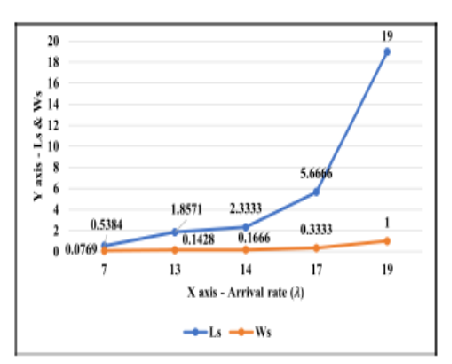


Indian Journal of Science and Technology
DOI: 10.17485/IJST/v17i12.2852
Year: 2024, Volume: 17, Issue: 12, Pages: 1167-1179
Original Article
S Nivetha Therasal1*, M Thiagarajan1
1PG & Research Department of Mathematics, St. Joseph’s College (Autonomous), Affiliated to Bharathidasan University, Tiruchirappalli, 620002, Tamil Nadu, India
*Corresponding Author
Email: [email protected]
Received Date:11 November 2023, Accepted Date:28 February 2024, Published Date:14 March 2024
Objectives: This study aims at (i) introducing the finite capacity of the interdependent queueing model with breakdown and controllable arrival rates, (ii) calculating the average number of clients in the system, and identifying the expected waiting period of the clients in the system, (iii) dealing with the model descriptions, steady-state equations, and characteristics, which are expressed in terms of , and (iv) analyzing the probabilities of the queueing system and its characteristics with numerical verification of the obtained results. Methods: While providing the input, the arrival rates through faster and slower arrival rates are controlled using the Poisson process. Also, the service provides an exponential distribution. The server provides the service on an FCFS basis. In this article, two types of models are used: and which are the system’s conditions, where represents the number of units present in the queue in which their probability is and . All probabilities are distributed based on the speed of advent using this concept. Then, the steady-state probabilities are computed using a recursive approach. Findings: This paper discovers the number of clients using the system on average and the expected number of clients in the system using the probability of the steady-state calculation. Little’s formula is used to derive the expected waiting period of the clients in the system. Novelty: There are articles connected to the finite capacity of failed service in functioning and malfunctioning, but this takes the initiative to provide a link in connection with the rates of the controllable arrivals and interdependency in the arrival and service processes. Mathematics Subject allocation: 60K25, 68M20, 90B22.
Keywords: M/M/1/K Queue Model, Finite Capacity, Breakdown, Controllable Arrival rates, FCFS Queue Discipline
© 2024 Therasal & Thiagarajan. This is an open-access article distributed under the terms of the Creative Commons Attribution License, which permits unrestricted use, distribution, and reproduction in any medium, provided the original author and source are credited. Published By Indian Society for Education and Environment (iSee)
Subscribe now for latest articles and news.